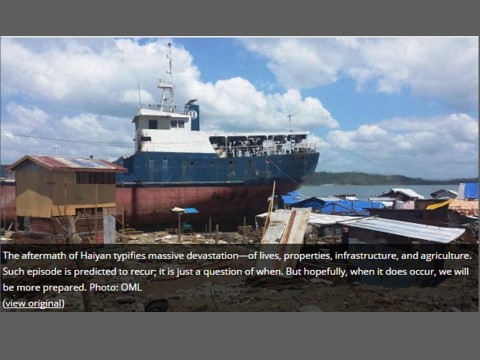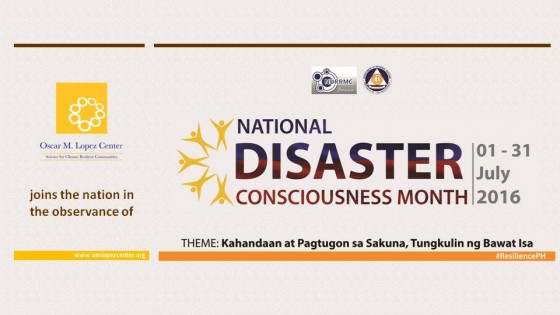Achieving a Level of Preparedness for Disasters

Fading El Niño, Brewing La Niña
November 15, 2016
Coping with threats on food security: lessons from Haiyan
November 15, 2016With the weakening of the El Niño and the onset of the rainy season, everyone is once again called upon to prepare – this time for La Niña, the opposite of El Niño, that is characterized by above normal rainfall and strong monsoon activity. (La Niña can also bring floods and landslides so watch out for our next article on the La Niña phenomenon for more info.)
The government is taking the lead in preparing for the potential effects of La Niña on the agricultural sector, with plans to provide assistance to farmers and fisher folk who would be affected. The MMDA recently mounted its 2nd Metro Manila Shake Drill which attempted to simulate the aftermath of a 7.2 magnitude earthquake. And by July, the nation is enjoined to observe National Disaster Consciousness Month to raise public awareness to the threats of disasters and to strengthen the government’s disaster response and preparedness programs.
This need to prepare is the same spirit that inspired a group known, and currently chaired by the Philippines, as the Vulnerable Twenty Group of Finance Ministers (V20) to spearhead the creation of the Global Partnership for Preparedness. Launched last May, the Partnership aims to help vulnerable countries attain a basic level of preparedness to climate risks and disasters by 2020.
Some Basic Acts of Preparedness
So what is a minimum level of preparedness that we all must achieve?
Preparedness operates on many levels, from the national scale, down to institutions and individuals. While each one will have to have their own preparedness plan, each one must also work with others to make sure preparedness is achieved all throughout the community. Whether you are wanting to ensure the safety of your family, the continuity of your business, or the responsiveness of the local community, here are a few basics on how to be prepared:

1. Have a plan. Whether for your home, the workplace or the community, it will be best if you have a plan – what to do, what to bring, where to go. When disaster strikes, there is no time to talk, much less talk about a plan! Every second counts, and the more time spent on doing rather than talking or thinking can spell the difference between life and death. There are various plans for each type of disaster already available, such as the STOP-DROP-ROLL for fires, and the DUCK-COVER-HOLD for earthquakes. You can find a variety of printable reminders or posters on the internet, but you will have to create your own emergency escape plan based on your locality.
2. Be equipped. Nothing like being prepared than having what you need when you need it most – an umbrella when it rains, recharged lamps during a brownout, extra stash of food and water when floods prevent you from going out and force stores to close. Having a Go Bag is one of the simplest things you can do to increase your level of preparedness. There are now a great variety of go bags available, from basic first aid kits to fancy survival gears. Choose the one that best fits your needs, or build your own. Don’t forget to include a list of emergency numbers in your area, such as this one for Pasig City:
3. Do dry runs. As they always say, practice makes perfect. But more important than getting it perfect, is developing the habit – the habit of preparedness and response that is second nature. And the only way to do that is to practice. A study on habits revealed that it takes, on average, 66 days to form a habit. Although the study showed that it can take as little as 18 days or as long as 254 days, and that missing a day or two does not impact your chances of forming the habit, what was more important was your commitment to the process. So practice. Practice at home and in the workplace. Join community drills. Better yet, start one!
These three tips are as good a place to start as any to being prepared. For more tips, we are happy to share with you this video on preparedness from foremost expert on disaster preparedness and advanced technical and medical rescue operations, Dr. Ted Esguerra.* Doc Ted, as he is fondly called, heads the Disaster Preparedness and Emergency Response Unit of the Energy Development Corporation.
Watch out for our next advisory as we tell you more about La Niña.
Remember, be aware and be prepared. Choose resilience.
RELATED: Here comes the rain again; Rhythm of the falling rain; Through the rain
*Among his other credentials, Doc Ted is also known for being the Expedition and Wilderness Emergency Medical Services Physician of the Philippine Mt. Everest Expedition Team (yes, he is a medical doctor). In fact, he is a certified flight surgeon as he has also clocked in flight hours as a helicopter pilot. He is a member of both national and international disaster response networks and has accreditation for cardiac and trauma emergency rescue. He is the Officer in Charge of the Specialized Medical Assistance Response Team (SMART), the elite medical rescue team of the Philippine Coast Guard.


